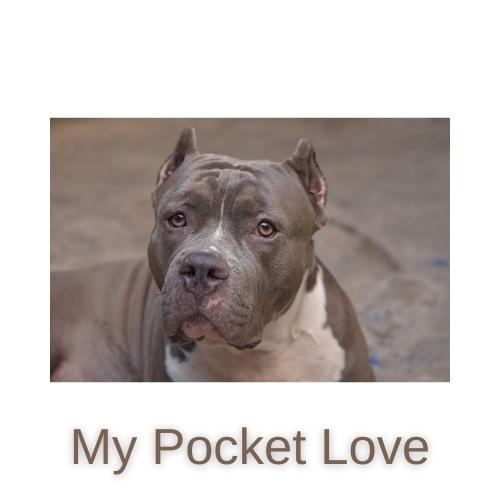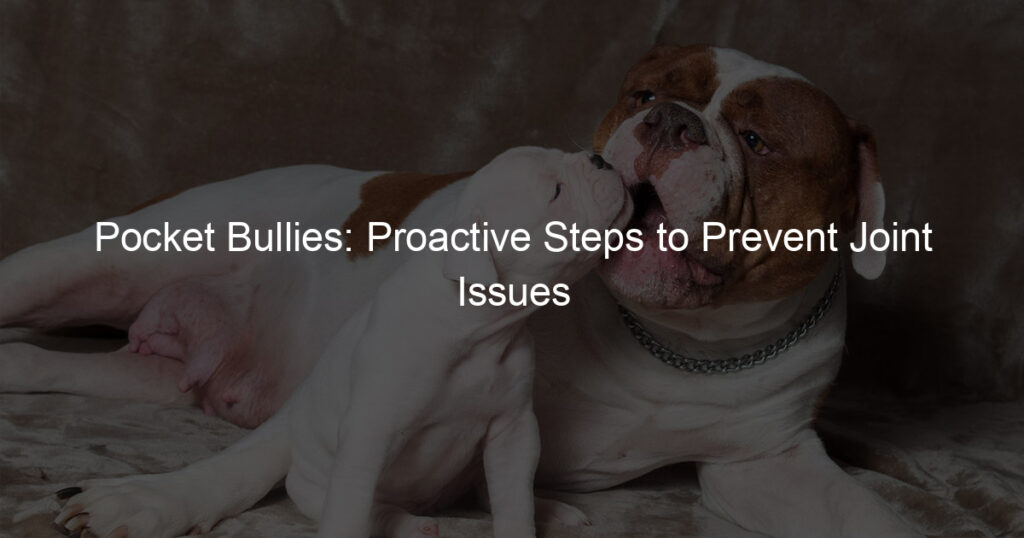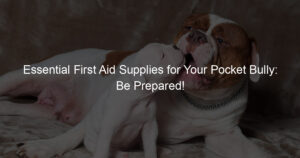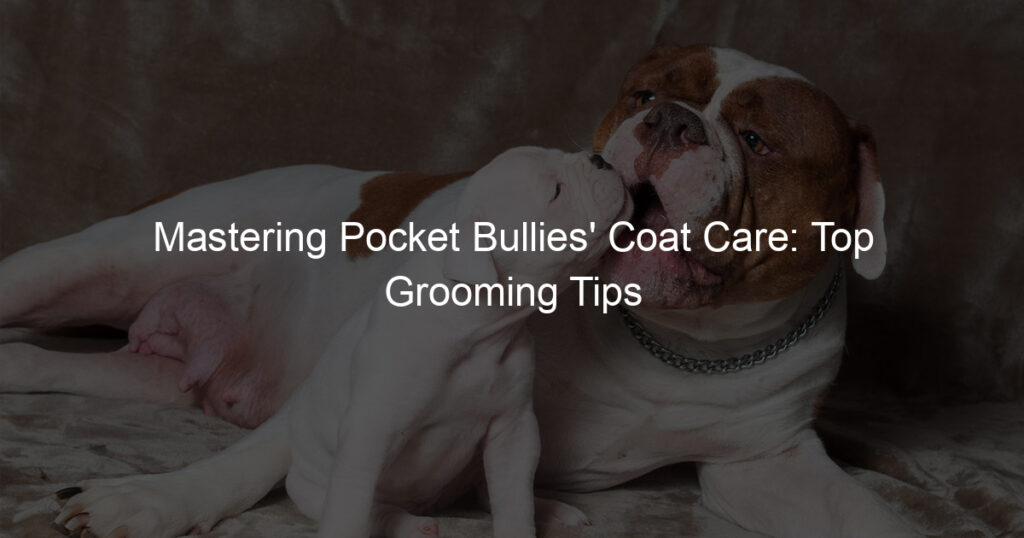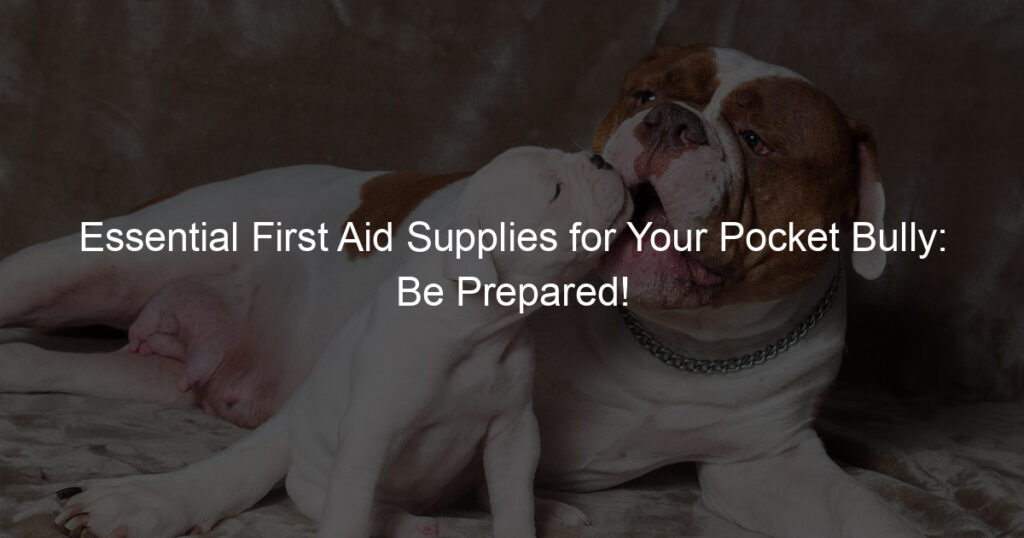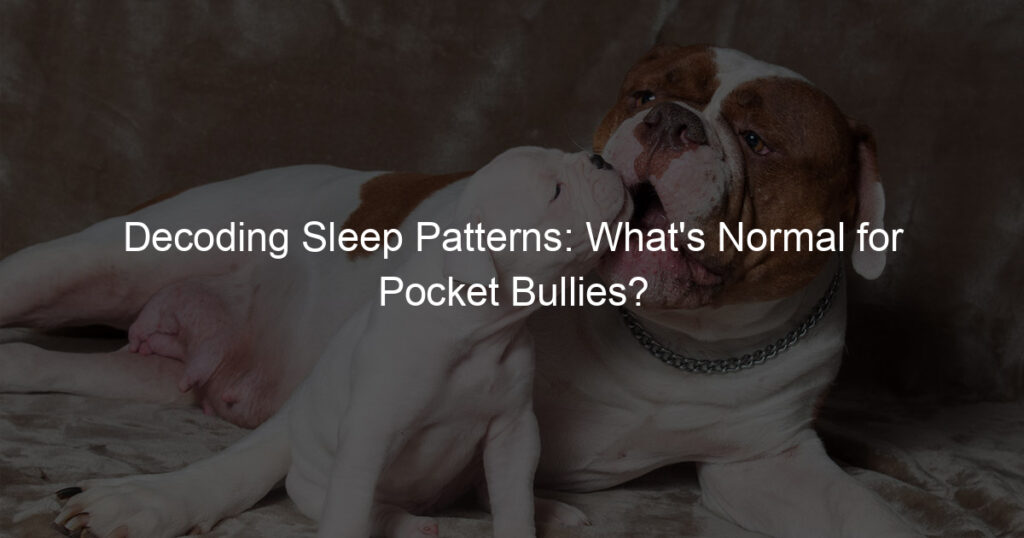
Introduction to Pocket Bullies Joint Health
As a dog lover, it’s important to understand the unique health needs of different breeds. In this post, we’ll be focusing on a breed known for its strength and compact size – the Pocket Bullies. We’ll delve into the importance of joint health for these dogs and discuss common joint-related health issues they may face.
- Overview of the Pocket Bullies Breed
- Importance of Joint Health in Pocket Bullies
- Common Pocket Bullies Health Issues Related to Joints
Pocket Bullies, a member of the American Bully breed, are known for their muscular build and compact size. Despite their tough exterior, they are friendly, affectionate, and great with families. However, like all breeds, they have their own set of health concerns, with joint health being a primary focus.
Joint health is crucial for Pocket Bullies. Their muscular build puts extra pressure on their joints, which can lead to health problems if not properly cared for. Healthy joints allow these dogs to move freely and enjoy an active lifestyle. Without proper joint care, a Pocket Bully’s quality of life can significantly decrease.
There are several joint-related health issues that Pocket Bullies can face. These include Hip Dysplasia, a condition where the hip joint doesn’t form correctly, and Elbow Dysplasia, a similar condition that affects the elbow joint. Both can lead to arthritis if not treated early. Another common issue is Patellar Luxation, where the kneecap dislocates or moves out of its normal location.
Understanding these health issues is the first step in ensuring your Pocket Bully’s joint health. In the following sections, we’ll delve deeper into these problems, discuss ways to prevent them, and share stories of Pocket Bullies who have overcome joint health challenges.
Understanding Joint Problems in Pocket Bullies
Joint problems are a common health issue in Pocket Bullies. These small, muscular dogs are prone to a variety of joint issues that can affect their quality of life. Understanding the causes of these problems can help owners take preventative measures and provide the best care for their pets.
Causes of Joint Problems in Pocket Bullies
There are several factors that can contribute to joint problems in Pocket Bullies. Here are the four main causes:
- Genetic predisposition: Some Pocket Bullies are genetically predisposed to joint problems. This means that they have inherited genes from their parents that make them more likely to develop these issues. It’s important to know your dog’s genetic history to understand their risk.
- Obesity: Excess weight puts additional strain on a dog’s joints, which can lead to problems over time. Keeping your Pocket Bully at a healthy weight can help prevent these issues.
- Injury: Injuries can also lead to joint problems in Pocket Bullies. This can include anything from a minor sprain to a serious fracture. It’s important to seek veterinary care if your dog is injured to prevent long-term damage.
- Aging: As Pocket Bullies get older, their joints naturally start to wear down. This can lead to arthritis and other joint issues. Regular vet check-ups can help catch these problems early.
Understanding these causes can help you take steps to prevent joint problems in your Pocket Bully. In the next section, we’ll discuss some of the signs to look out for that may indicate your dog is experiencing joint issues.
Signs of Joint Problems in Pocket Bullies
As a Pocket Bully owner, it’s crucial to be aware of the signs that your pet may be experiencing joint problems. These signs can be subtle, but if you’re observant, you’ll be able to spot them. Here are some of the most common signs of joint problems in Pocket Bullies:
- Difficulty moving: If your Pocket Bully is having trouble getting up, sitting down, or moving around, this could be a sign of joint problems. They might also be less active than usual, or they might avoid activities they usually enjoy.
- Swelling in joints: Swelling in the joints is another common sign of joint problems. If you notice that your Pocket Bully’s joints are larger or more swollen than usual, this could be a sign of a joint problem. The swelling might be accompanied by heat or redness.
- Visible pain when walking: If your Pocket Bully appears to be in pain when they’re walking, this could be a sign of joint problems. They might limp, or they might favor one leg over the other. They might also show signs of discomfort when you touch their joints.
These signs are a clear indication that your Pocket Bully might be suffering from joint problems. If you notice any of these signs, it’s important to consult with a veterinarian as soon as possible. Early detection and treatment can help to prevent further damage and ensure that your Pocket Bully can lead a happy and healthy life.
Preventing Joint Problems in Pocket Bullies
One of the most effective ways to prevent joint problems in Pocket Bullies is to ensure they receive proper nutrition. A well-balanced diet can help maintain healthy joints and reduce the risk of joint issues.
Proper Nutrition for Joint Health
Proper nutrition plays a vital role in maintaining the overall health of your Pocket Bullies, including their joint health. Here are some key points to consider:
- Importance of a Balanced Diet
- Supplements for Joint Health
A balanced diet is crucial for your Pocket Bullies’ overall health and wellbeing. It provides all the essential nutrients that your dog needs to stay healthy and active. A diet rich in proteins, carbohydrates, fats, vitamins, and minerals can help strengthen your dog’s joints and prevent joint problems. For instance, Omega-3 fatty acids, found in fish and flaxseeds, are known to reduce inflammation and can help maintain healthy joints.
While a balanced diet is essential, sometimes, your Pocket Bullies might need a little extra help. This is where supplements come in. Certain supplements are designed to support joint health in dogs. Glucosamine and chondroitin are two such supplements that are often recommended for dogs with joint issues. They help to repair damaged cartilage and improve joint function. However, it’s important to consult with your vet before starting any new supplement regimen for your dog.
In conclusion, a balanced diet and appropriate supplements can play a significant role in preventing joint problems in Pocket Bullies. Remember, your pet’s health is in your hands, so make sure to provide them with the best possible care.
Regular Exercise and its Impact on Joint Health
Exercise plays a crucial role in maintaining the overall health of your Pocket Bullies. Regular physical activity can significantly improve their joint health and help prevent joint problems. Let’s delve into the recommended exercises for Pocket Bullies and the benefits of regular exercise for joint health.
- Recommended exercises for Pocket Bullies
- Walking: A daily walk can help keep your Pocket Bullies active and their joints flexible. Start with short walks and gradually increase the distance as your pet gets used to the exercise.
- Swimming: Swimming is a low-impact exercise that is excellent for joint health. It allows your Pocket Bullies to move their joints without putting too much pressure on them.
- Play Fetch: Playing fetch is a fun way to keep your Pocket Bullies active. It encourages movement and helps improve joint flexibility.
- Benefits of regular exercise for joint health
- Improves Joint Flexibility: Regular exercise helps maintain the flexibility of your pet’s joints, which can prevent stiffness and pain.
- Strengthens Muscles: Exercise helps strengthen the muscles around the joints, providing better support and reducing the risk of joint problems.
- Promotes Healthy Weight: Regular exercise can help your Pocket Bullies maintain a healthy weight, reducing the strain on their joints.
When it comes to exercising your Pocket Bullies, it’s essential to choose activities that are gentle on their joints. Here are some recommended exercises:
Regular exercise offers numerous benefits for the joint health of your Pocket Bullies. Here are some key benefits:
In conclusion, regular exercise is essential for the joint health of your Pocket Bullies. By incorporating the recommended exercises into your pet’s routine, you can help prevent joint problems and ensure a healthier, happier life for your furry friend.
Joint Care for Pocket Bullies
Ensuring the health and longevity of your Pocket Bully involves taking good care of their joints. This is particularly important as these dogs are prone to certain joint issues. Let’s delve into the importance of regular vet check-ups for joint health.
Regular Vet Check-ups
Regular vet check-ups are a crucial part of maintaining your Pocket Bully’s joint health. These visits allow for early detection of potential issues, ensuring that your pet gets the necessary care and treatment as soon as possible.
- Importance of regular vet visits
- What to expect during a joint health check-up
Regular vet visits are essential for several reasons. Firstly, they allow for early detection of potential joint issues. This is crucial as early detection often means a better prognosis. Secondly, regular check-ups provide an opportunity for your vet to monitor your dog’s overall health and make recommendations for diet, exercise, and care that can help prevent joint issues. Lastly, these visits also allow your vet to keep your dog’s vaccinations up to date, which is important for overall health.
During a joint health check-up, your vet will likely start with a general examination of your dog. This includes checking their weight, heart rate, and temperature. They will then move on to a more specific examination of the joints. They may feel the joints to check for any swelling or pain, and observe your dog’s movement to look for any signs of discomfort or difficulty. They may also take x-rays or perform other tests if needed. Your vet will then discuss their findings with you and make recommendations for any necessary treatments or changes in care.
Regular vet check-ups are an essential part of joint care for Pocket Bullies. By staying on top of these visits, you can help ensure a long, healthy, and happy life for your pet.
Physical Therapy for Pocket Bullies with Joint Issues
Physical therapy is a powerful tool for managing joint issues in pocket bullies. It can help to alleviate pain, improve mobility, and enhance the overall quality of life for your pet. Let’s delve into the benefits of physical therapy and the different types that can promote joint health.
- Benefits of Physical Therapy
- Pain Relief: Physical therapy can help to reduce pain and discomfort in your dog’s joints. This can make a significant difference in their overall comfort and happiness.
- Improved Mobility: Regular physical therapy can help to improve your dog’s mobility, making it easier for them to move around and enjoy their daily activities.
- Enhanced Quality of Life: By reducing pain and improving mobility, physical therapy can enhance your dog’s overall quality of life.
- Types of Physical Therapy for Joint Health
Physical therapy offers numerous benefits for pocket bullies struggling with joint problems. Here are some of the key advantages:
There are various types of physical therapy that can be beneficial for pocket bullies with joint issues. Here are some of the most effective ones:
| Type of Therapy | Description |
|---|---|
| Hydrotherapy | This involves exercises in water, which can help to reduce pressure on your dog’s joints and improve their strength and flexibility. |
| Massage Therapy | Massage can help to relieve tension in your dog’s muscles, reducing pain and improving mobility. |
| Stretching Exercises | Regular stretching can help to improve your dog’s flexibility and range of motion, making it easier for them to move around. |
Remember, it’s important to consult with a vet or a professional animal physical therapist before starting any new therapy regimen. They can provide guidance on the best types of therapy for your dog’s specific needs and ensure that the exercises are done safely and effectively.
Case Studies: Overcoming Joint Problems in Pocket Bullies
Let’s take a look at two real-life examples of Pocket Bullies who have successfully overcome joint problems. These case studies will provide valuable insights into the management and prevention of joint diseases in these adorable dogs.
-
Case Study 1: Successful Management of Joint Disease
Meet Bruno, a 4-year-old Pocket Bully who started showing signs of joint discomfort. His owner, noticing Bruno’s difficulty in moving, took him to a vet. The vet diagnosed Bruno with early-stage joint disease. Bruno’s owner was determined to help him and started a comprehensive joint care plan.
The plan included a balanced diet rich in Omega-3 fatty acids, regular low-impact exercises like swimming, and joint supplements. Bruno’s owner also made sure he maintained a healthy weight to reduce pressure on his joints. Within a few months, Bruno showed significant improvements. His mobility increased, and he was back to his playful self. This case study highlights the importance of early detection and proper management of joint disease.
-
Case Study 2: Impact of Preventative Care on a Pocket Bullies’ Joint Health
Next, let’s talk about Daisy, a Pocket Bully puppy. Daisy’s owner, aware of the breed’s susceptibility to joint problems, decided to start preventative care from a young age. Daisy was put on a diet that promoted joint health, including foods rich in glucosamine. She was also given regular, gentle exercise to keep her joints strong.
As Daisy grew, her owner continued this preventative care routine. Today, Daisy is a healthy adult Pocket Bully with no signs of joint problems. This case study demonstrates the positive impact of preventative care on a Pocket Bully’s joint health.
These case studies show that with proper care and attention, joint problems in Pocket Bullies can be managed or even prevented. Remember, your Pocket Bully depends on you for its health and happiness. So, make sure you provide the best care possible for your furry friend.
Conclusion: Ensuring a Healthy Life for Your Pocket Bullies
As we conclude this comprehensive guide on joint health for Pocket Bullies, let’s take a moment to recap the proactive steps we can take to prevent joint issues and emphasize the importance of awareness and early detection.
- Recap of proactive steps for preventing joint issues:
- Importance of awareness and early detection:
Preventing joint problems in Pocket Bullies involves a combination of balanced nutrition, regular exercise, and routine vet check-ups. A diet rich in essential nutrients like Omega-3 fatty acids can help maintain joint health. Regular, low-impact exercise such as walking or swimming can keep your Pocket Bullies active without putting undue stress on their joints. Regular vet check-ups are crucial for early detection of potential joint problems.
Being aware of the signs of joint problems in your Pocket Bullies is the first step towards ensuring their health and well-being. Early detection of symptoms like limping, difficulty in moving, or swelling can make a significant difference in managing the condition and improving your pet’s quality of life. Remember, the sooner a problem is detected, the better the chances of managing it effectively.
In conclusion, the health of your Pocket Bullies is in your hands. By being proactive, aware, and attentive to their needs, you can ensure they lead a healthy, happy, and active life. Remember, a healthy Pocket Bully is a happy Pocket Bully!
